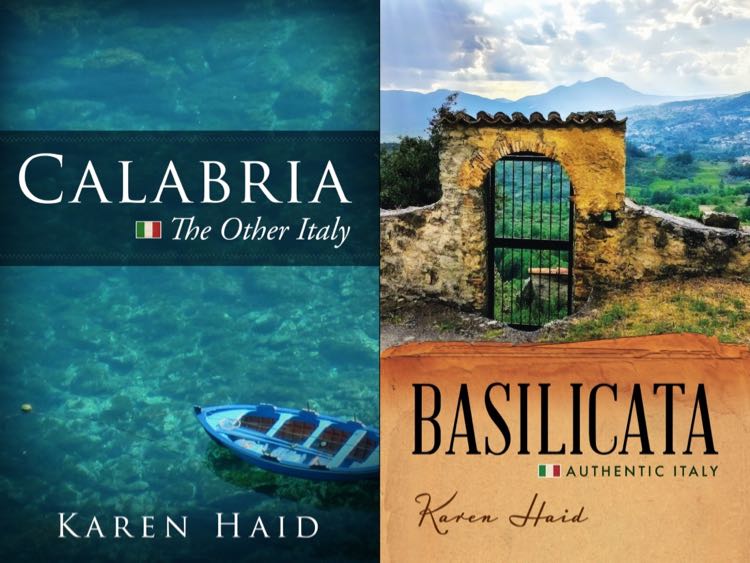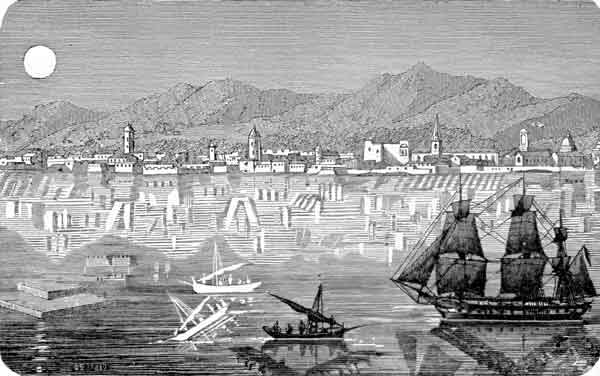“I have never beheld the enchantment of the Straits of Messina, that Fata Morgana, when, under certain conditions of weather, phantasmagoric palaces of wondrous shape are cast upon the waters – not mirrored, but standing upright; tangible, as it were; yet diaphanous as a veil of gauze.” Thus spake Norman Douglas in his Old Calabria. The extraordinary vision, looking across the Strait of Messina from Reggio Calabria to Sicily has eluded me, as well, in all my time spent in the Città della Fata Morgana.
WHAT IS THE FATA MORGANA?
In Reggio, it is said that the Fata Morgana is best seen on particularly warm, muggy days, at daybreak when the special combination of refraction and reflection create the mirage-like effect over the water. Yet, I remember seeing a photo in a Calabrian newspaper a number of years ago of the phenomenon on a cold winter’s day.
Scientific explanations describe the Fata Morgana as a result of thermal inversion, where a layer of warmer air is above cooler air, which is the opposite of normal circumstances. This atmospheric condition causes an optical phenomenon due to the bending of light rays as they pass through the different temperatures. For this to occur, an atmospheric duct must have formed, as this horizontal layer is what acts as a refracting lens that can produce both inverted and erect images. Importantly, the curvature of the light rays within the duct have to be greater than the curvature of the earth’s surface. And to be able to see it, the observer must be either at the level of this atmospheric duct or below it.
Simply put, you have to be in the right place at the right time.
WHY IS IT CALLED THE FATA MORGANA?
As for why this phenomenon in the Strait of Messina is called the Fata Morgana, I will quote another travel writer, H. V. Morton, who also did not see the image during his stay in Reggio, but recorded an explanation for its name in A Traveller in Southern Italy.
As interesting as the optical delusion is the name, which was given to it by the Normans. “Fata” in Italian means “fairy”, and the Fairy Morgana was no other than King Arthur’s rather difficult sister, Morgan le Fay. Having seen King Arthur upon the pavement of Otranto Cathedral, to meet Morgan le Fay in the Straits of Messina was not as surprising as it might have been. There is a story that Roger of Hauteville stood one day upon the Reggio side of the Straits and wished for a fleet in order to conquer Sicily. Suddenly, from her palace beneath the waves, rose up Morgan le Fay and spread the mirage before him, bidding him to cross. But Roger, full of Norman commonsense, declined to do so, saying something to the effect that he would conquer Sicily with his strong right arm and not by the black art of sorcery.
This 1774 print from Messina’s Regional Library shows an image of Reggio with a vague vision of the Fata Morgana in the Strait of Messina.
FATA MORGANA MYTHS
We are all familiar with the image of the mirage in the desert. Perhaps the Fata Morgana on water is not as popular a subject in our collective mind’s eye. Of course, if you haven’t ever seen it for yourself, your mind might wander to such a fanciful image from a late nineteenth-century children’s book.
In Round-about Rambles in Lands of Fact and Fancy, Frank R. Stockton explains the phenomenon seen in the Strait of Messina to his young readers:
People used to believe in a fairy called Fata Morgana. Wonderful things were said of her, and her dominions were in the air, where she had large cities which she sometimes amused herself by turning into a variety of shapes. The cities were often seen by dwellers on the Mediterranean sea-coast. Sometimes one of them would be like an earthly city, with houses and churches, and nearly always with a background of mountains. In a moment it would change into a confused mass of long colonnades, lofty towers, and battlements waving with flags, and then the mountains reeling and falling, a long row of windows would appear glowing with rainbow colors, and perhaps, in another instant, all this would be swept away, and nothing be seen but gloomy cypress trees.
These things can be seen now occasionally, as of old, but they are no longer in Fairyland. Now we know that they are the images of cities and mountains on the coast, and the reason they assume these fantastic forms is that the layers of air through which the rays of light pass are curved and irregular.
REGGIO CALABRIA, CITTÀ DELLA FATA MORGANA
The ethereal vision has given rise to legends, and other conquerors, less attractive to the Fata Morgana, herself, have not been as fortunate as the Normans and have drowned in the straits, fooled in thinking that the other side was just a handful of footsteps away. And over time, Reggio has embraced the name, City of the Fata Morgana.
For those not fortunate to catch a glimpse of this rare vision on a trip to Reggio Calabria, there are a few artist’s interpretations of the phenomenon around town. The easiest to see is in the Palazzo della Cultura. Artist Santina Orrico in Falvo presents her 20th-century print on canvas entitled Il Risveglio della Fata Morgana or Awakening of the Fata Morgana.
You have to crane your neck for Francesco Galante’s allegorical painting on the ceiling of one of the magnificent reception rooms in Palazzo Corrado Alvaro, seat of the provincial government in Piazza Italia. Take a good look at the Fata with a triton in her hand and riding in her horse-drawn chariot accompanied by cherubs amidst layers of urban images, as the hall is only open to the public on occasion.
And finally, in Palazzo Campanella, the seat of the regional government, there is the beautiful painting “La Fata Morgana” by Maurizio Carnevali. You may be able to distinguish Messina and its cathedral, but you will surely see how the two cities are joined by this unique, mysterious lady of the straits.
Would you like to visit Reggio Calabria and see the beautiful Strait of Messina for yourself, and perhaps try to catch a glimpse of the elusive Fata Morgana? Join me on one of my small-group Calabria tours! Read more about Southern Italy – everything from ancient history to contemporary society with interesting places to visit, encounters with locals and lots of food – in my two books Calabria: The Other Italy and Basilicata: Authentic Italy.
“Recommended to readers who appreciate all things Italian” – Library Journal
“Like” Basilicata Facebook page, Calabria: The Other Italy’s Facebook page and follow me on Karen’s Instagram and Karen’s Twitter for beautiful pictures and information.
Sign up below to receive the next blog post directly to your email for free.






Comments 9
I continue to enjoy your communications about Calabria and found the Fara Morgana especially educational! You have a heart for Italy, that’s obvious, however, your ability to teach is equally evident!
I have your Calabria book, and will be getting your second book on Basilicata.
May 2021 bring joy and Peace
Author
Thank you, so glad you’re enjoying my posts and books! All the best to you, as well, con auguri di gioia e di pace per l’Anno Nuovo.
Molto interessante! I mostly relate Fata Morgana to gelato in Roma, and forgot that she was King Arthur’s sorceress sister. The colours in that print are absolutely gorgeous! I hope we can travel again soon. Ti auguro un migliore Nuovo Anno-uno di gioia e salute! Ciao, Cristina
Author
The name of the gelato shop piqued my interest, so I looked it up and as it turns out, the founder is one of your own! Maria Agnese Spagnuolo from Taranto selected the name Fata Morgana for her shop as she had apparently seen the phenomenon one time along the Straits of Messina. Ricambio gli auguri per l’Anno Nuovo con la speranza che tutto andrà bene!
Molto cool! it is among the best gelato I have had! I hope we can both get back to eating gelato in Italia soon! Ciao, Cristina
When I first heard of the Fata Morgana I was so intrigued! These images are so interesting, I’ve never been lucky enough to see this effect myself, but I’m sure it would be quite a treat to see!
Author
It would certainly be a memorable experience!
How cool is this! Never experienced a mirage either in the desert or upon the water…as you say the conditions have to be just right, but the mind wanders along so many fantasy tales born of both landscapes, which may have been inspired by this experience. Your collection of artwork for this post gives me the perfect haunted feeling that I am seeing things I’m not quite understanding in these masterpieces. Wishing you a healthy new year, and thank you for a 2020 full of wonderful conversations.
Author
I recall having seen a couple of photos of the phenomenon in the strait and I remember them looking more surreal than these paintings, but definitely images that made me think my mind was playing tricks on me. All the best to you and the continued conversations in 2021.